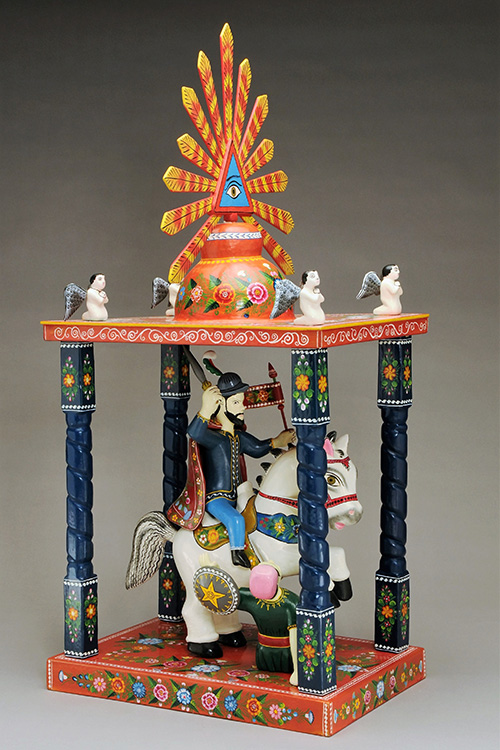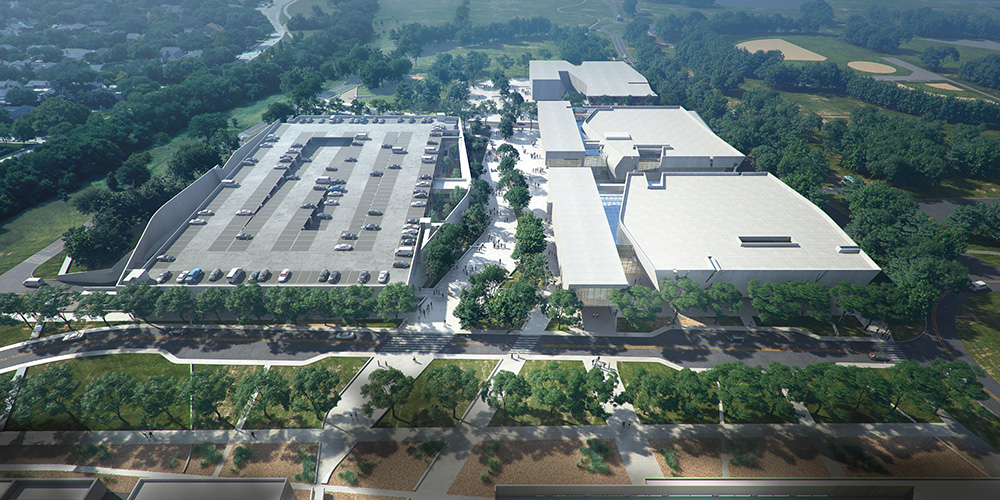Edith and Peter O’Donnell Jr. Athenaeum Begins New Era for UTD Arts
By: Office of Media Relations | May 11, 2022

The University of Texas at Dallas broke ground today on the Edith and Peter O’Donnell Jr. Athenaeum, a new cultural district located on approximately 12 acres at the southeastern edge of the campus, creating a new gateway to the University as well as a destination for students, faculty, staff and the community that will foster engagement in the arts and learning.
Designed by global architecture and design firm Morphosis, the project includes three new buildings — the second location for the Crow Museum of Asian Art, a performance hall and a planned museum for the traditional arts of the Americas — in addition to a parking structure, all surrounding a central plaza that serves as the heart of the master plan.

The Athenaeum is supported by a $32 million gift from the O’Donnell Foundation, the single largest monetary gift from one of UT Dallas’ most significant donors. In addition to the Crow Collection, the University has also received gifts of three collections of Latin American folk art: the Roger Horchow Collection, the Laura and Dan Boeckman Collection of Latin American Folk Art, and the Bryan J. Stevens Collection of Masks of the Sierra de Puebla.
Phase I of the O’Donnell Athenaeum, the campus location of the Crow Museum of Asian Art, is anticipated to be completed in spring 2024.
“As an expression of human intellect and creativity, the arts play an important role at UT Dallas by enhancing the University’s focus on science, technology, engineering, mathematics and management. But to ensure that UT Dallas develops versatile individuals, we must integrate the arts fully into our vision and the experience of our students,” said UT Dallas President Richard C. Benson, the Eugene McDermott Distinguished University Chair of Leadership. “Thanks to the transformative gift from the O’Donnell Foundation, as well as lead gifts from the Crow family and other generous Dallas families, we can now realize this vision for the Athenaeum, creating vibrant spaces commensurate with our aspirations for UT Dallas and becoming a hub for the arts in North Texas.”
Edith and Peter O’Donnell Jr. Athenaeum
The O’Donnell Athenaeum is the latest milestone in a period of significant growth of the arts at UT Dallas, which began in 2014 with the creation of the Edith O’Donnell Institute of Art History (EODIAH), established through a generous endowment from arts patron Edith O’Donnell and designed to approach art history through multidisciplinary research at a university on the cutting edge of science and technology. Dr. Richard Brettell, founding director of EODIAH, began developing the vision for the Athenaeum, convening spaces for reflection and discussion across disciplines, spanning the visual and performing arts, literature and science. Global in reach, the Athenaeum is envisioned to bridge the UT Dallas and local communities.
“Thanks to the transformative gift from the O’Donnell Foundation, as well as lead gifts from the Crow family and other generous Dallas families, we can now realize this vision for the Athenaeum, creating vibrant spaces commensurate with our aspirations for UT Dallas and becoming a hub for the arts in North Texas.”
UT Dallas President Richard C. Benson
In 2019, the Athenaeum began to take shape when the Trammell and Margaret Crow family donated the entire collection of the Trammell and Margaret Crow Museum of Asian Art, together with $25.45 million of support funding for a new museum on the UT Dallas campus. The Crow Museum’s collection demonstrates the diversity of Asian art, with more than 1,000 works from Cambodia, China (including Tibet), India, Indonesia, Japan, Korea, Myanmar, Nepal, Pakistan, Thailand and Vietnam, spanning from the ancient to the contemporary, as well as a library of more than 12,000 books, catalogs and journals. The downtown Dallas Arts District location will continue to present a full exhibition and program calendar.
The three collections of Latin American folk art, along with additional planned collections, will form the basis of a second museum within the Athenaeum focused on the University’s growing collection of Mexican art and folk art of the Americas:

- The Roger Horchow Collection (Dallas), donated by the Horchow family, includes approximately 200 works of painted Mexican wood, ceramic and papier-mâché sculptures. Primarily collected for decorative purposes, Horchow’s significant collection represents a wide range of popular folk art characterized by its whimsy, intricacy, craftsmanship and rarity.
- The Laura and Dan Boeckman Collection of Latin American Folk Art (Dallas) concentrates on Mexican folk art created from the late 1980s through the present, acquired during the course of the couple’s travels throughout Mexico. The Boeckman collection includes the works from prominent Mexican artists such as the late Oaxacan woodcarving master Manuel Jiménez; clay artist Carlomagno Pedro Martínez from San Bartolo Coyotepec, Oaxaca; and sculptor Enedina Vasquez.
- The Bryan J. Stevens Collection of Masks of the Sierra de Puebla (Philadelphia), donated by David Stevens, the son of the late collector Bryan Stevens, features approximately 1,600 Mexican dance masks from the Sierras north of Puebla, Mexico. Stevens began collecting masks in 1987, drawn to their multifaceted meanings, designs and purposes.
Architecture and Design
After an international search led by Brettell, in late 2019 UT Dallas selected Los Angeles-based Morphosis to design the Athenaeum. The firm created a cohesive vision and master plan for the Athenaeum, where architecture and landscape combine to form a dynamic new district with a distinct identity that establishes UT Dallas as a cultural hub. The heart of the project is defined by a 2-acre plaza, flanked by new buildings on the east and west sides, which will feature landscaped gardens; tree-lined walkways; paved open spaces with benches and water features; an amphitheater; and contemporary sculpture from the Crow Museum’s collection. Landscaping and open space are used intentionally in the master plan to knit together the various buildings within the district and to create an important link to the rest of the campus.
“This new space allows us to grow our collection and programs and, as part of a top-tier research university, expand our research and conservation initiatives, all while fulfilling our mission of being a museum of relevance and belonging for UT Dallas students and faculty, and the larger North Texas community.”
Amy Hofland, senior director of the Crow Museum of Asian Art at UT Dallas
Lining the western edge of the plaza will be three buildings: the two-story, 68,000-square-foot Crow Museum, which includes 12,000 square feet of contiguous outdoor space for programs and events (Phase I); a two-story, 53,000-square-foot performance hall including a 600-seat concert hall, practice rooms, and choral and orchestra rehearsal rooms (Phase II); and a two-story, 50,000-square-foot museum for the traditional arts of the Americas (Phase III). On the eastern edge of the plaza, masked by a freestanding wall, will be a three-story 1,100-car parking structure with two levels above grade and one basement level walkout that will serve the Athenaeum and campus.
The three cultural buildings are all designed with second floors that are larger than the ground floor, creating covered exterior spaces, where the buildings, plaza and landscaping fuse together to form intimate spaces that can be used for studying, building entry, daytime and nighttime events and gatherings, performances, art display and everyday campus life. Each building is clad with white precast concrete panels featuring a 3D pattern created through an innovative process designed by Morphosis.
“Morphosis is pleased to partner with The University of Texas at Dallas for this important project, giving us the opportunity to help shape the University’s bold vision for the arts on campus,” said Arne Emerson, Morphosis partner and the design partner leading the project. “The O’Donnell Athenaeum will transform the UT Dallas campus with buildings and open spaces for the visual and performing arts that will allow both students and the surrounding community to experience the convergence of art and architecture in ways not previously possible at the University.”
The new building includes 16,000 square feet of flexible gallery space. It will be anchored by the Crow Museum of Asian Art, with additional space for the display of new acquisitions or temporary exhibitions. Large windows at the ends of the galleries allow for ample natural light but can also be blacked out for more light-sensitive objects. The building will house a state-of-the-art conservation lab, seminar rooms, administrative offices, art storage and the Brettell Reading Room, which will house the personal library of Brettell. The Crow Museum will continue programming in its current space in the downtown Dallas Arts District, providing an extension of the campus museum.
“As one of the few museums in the U.S. dedicated to Asian art, the new museum at UT Dallas greatly expands the University’s commitment to Asian art,” said Amy Hofland, senior director of the Crow Museum of Asian Art at UT Dallas. “This new space allows us to grow our collection and programs and, as part of a top-tier research university, expand our research and conservation initiatives, all while fulfilling our mission of being a museum of relevance and belonging for UT Dallas students and faculty, and the larger North Texas community.”
New Dimensions: The Campaign for UT Dallas
The New Dimensions campaign — a $750 million effort to attract talent to North Texas, facilitate the enterprising work of faculty and realize the possibilities that exist when distinguished researchers and visionary artists share a home — will transform UT Dallas into a cultural destination for North Texas. The two museums and the performance hall of the O’Donnell Athenaeum, a significant initiative of the campaign, are funded through private contributions, with the parking structure funded through UT Dallas resources. To date, UT Dallas has raised a total of $73.9 million, including a $32 million gift ($22 million in capital funds for the Crow Museum and performance hall and $10 million to create a programming endowment) from the O’Donnell Foundation. With an additional $59.1 million to raise in capital funds for the Crow Museum and performance hall, the campaign has raised nearly 52% of the funds needed for the first two phases of the Athenaeum.
“Peter and Edith O’Donnell were crucial to the development of UTD, almost from the beginning. They saw the University as having the potential to blend their passion for education, Peter’s interest in science and engineering, and Edith’s love of the arts. All of this finds unique expression in the role envisioned for the Athenaeum, which makes it especially appropriate that the complex will bear the O’Donnell name,” said William T. Solomon, chairman, president and CEO of the O’Donnell Foundation.
Additional gifts for the Crow Museum include $10.95 million from Mrs. Margaret McDermott; $5 million from Mrs. Bea Wallace; $500,000 from Friends of Rick Brettell; and the gift from the Crow family.

Media Contact: The Office of Communications and Marketing, or the Office of Media Relations, UT Dallas, (972) 883-2155, newscenter@utdallas.edu.





